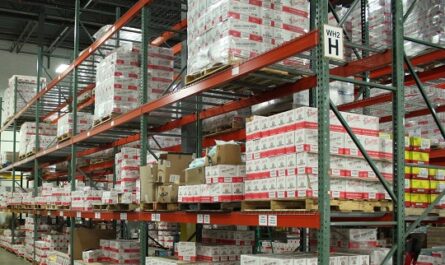Table of Contents
The Chaos You’re Dealing With
Picture this. You step into your warehouse, and before you even get to your desk, you’re hit with a dozen small fires waiting to be put out. Operators are running around trying to locate items, pickers are bumping into each other, and forklifts are struggling to navigate tight spaces. The receiving area is overflowing, and the packing station? A mess. Orders are taking too long to process, and mistakes are piling up.
You know something needs to change. The problem isn’t your team—they’re working hard. The real issue? Your warehouse layout isn’t working for you. Instead of making processes smoother, it’s making them harder. The good news? You don’t need to overhaul everything overnight. But if you want efficiency, fewer errors, and a stress-free operation, your warehouse layout needs to start working with you, not against you.
Before we go further into this topic, don’t forget to follow my LinkedIn account. You’ll get more helpful insights on supply chain management there.
Understanding the Flow Before Changing Anything
A lot of people make the mistake of rearranging racks or buying new equipment before they even understand how things move inside their warehouse. If you want an optimized layout, you have to start with the flow.
Think of your warehouse like a city. Just like how well-planned roads reduce traffic and make commuting easier, a well-thought-out warehouse layout makes picking, packing, and shipping faster. Start by mapping how goods move from receiving to storage, picking, packing, and finally shipping. If products keep crisscrossing each other’s paths, it’s no wonder your team is struggling.
You also need to factor in movement types. There’s inbound movement—how goods enter and get stored. Then there’s internal movement—how pickers, forklifts, and inventory flow through the space. And finally, outbound movement—how orders are processed and shipped out. If any of these are constantly clashing, your layout isn’t optimized yet.
Fixing Bottlenecks Without Guesswork
Every warehouse has bottlenecks, and if you’re feeling the chaos, yours probably has several. Maybe the picking area is congested because it’s too close to receiving. Maybe the packing station is too far from storage, slowing down order processing. Or maybe forklifts are sharing paths with pickers, causing slowdowns and safety risks.
The trick is to stop guessing and start observing. Spend a day walking through operations. Where do people stop unnecessarily? Where do they struggle? Where do delays happen? These pain points tell you exactly where the layout is failing.
Once you’ve identified bottlenecks, start thinking like a traffic engineer. If pickers are constantly waiting for forklifts to pass, create separate paths for them. If your receiving area is always full, expand it or move storage zones to make space. The goal is simple: make movement smooth, predictable, and frustration-free.
You might also like:
- Why Your Supply Chain Will Never Be Perfect and That’s Okay
- Do You Really Need a 3PL or Can You Handle Logistics In-House?
Zoning Your Warehouse for Maximum Speed
One of the biggest mistakes in warehouse layouts is treating everything the same. Not all products move at the same speed, so they shouldn’t take up the same type of space. The secret? Smart zoning.
Fast-moving items should always be stored near the picking and packing areas. You don’t want your best-selling products tucked away in a corner where pickers waste minutes retrieving them. Meanwhile, slow-moving products can go further back.
Heavy and bulky items need space. If your team is constantly struggling to move large pallets in a cramped space, you’re losing time and increasing injury risks. Give them enough room to maneuver without blocking traffic.
And let’s talk about seasonal inventory. If your warehouse sells different products depending on the season, don’t leave everything in the same spot year-round. Rotate stock locations based on demand. The more accessible popular products are, the faster your orders get out the door.

Making Receiving and Shipping Work in Your Favor
Receiving and shipping are the bookends of your warehouse operations. If either one is inefficient, the entire workflow suffers.
A common mistake? Having receiving and shipping areas too close to each other. It might seem logical at first, but in reality, it creates congestion. You don’t want incoming inventory getting in the way of outbound shipments. Keep these areas separate and ensure that receiving has enough space to stage, inspect, and process products without causing delays.
Another game-changer? Prepping your shipping area for efficiency. If workers have to run around looking for packing materials, labels, or paperwork, you’re wasting time. Organize packing stations so that everything is within reach. The fewer steps it takes to process an order, the faster it gets out the door.
Aisles That Work for You, Not Against You
If your aisles are too narrow, forklifts and carts can’t move efficiently. If they’re too wide, you’re wasting valuable storage space. The right aisle width depends on your equipment. If you’re using standard forklifts, your aisles should be wide enough for smooth turns but not so wide that they eat up space.
Also, think about traffic direction. One-way aisles reduce congestion and prevent accidents. If pickers and forklifts are constantly weaving around each other, you need to establish clear lanes and direction signs.
You might also like:
- Feeling Overwhelmed by Supply Chain Chaos? Here’s How an Action Plan with Milestones Can Save You
- Why Your Inventory Records Never Match the Physical Stock and How to Fix It
Keeping Everything Accessible Without Wasting Space
Storage layout can make or break warehouse efficiency. A common issue? Too many people struggling to reach the same area. If your best-selling items are in a single spot and everyone is crowding around them, it’s time to rethink placement.
Use a slotting strategy—store frequently picked items in multiple locations so that multiple pickers can access them at the same time. For smaller warehouses, vertical storage can be a lifesaver. Tall shelving with the right retrieval tools saves space while keeping everything organized.
Technology That Makes Layout Optimization Even Better
Even the best warehouse layout can be improved with the right technology. Warehouse Management Systems (WMS) can show you real-time data on product movement, helping you refine your layout over time. Barcode scanning reduces search time, and automation tools like conveyors or automated guided vehicles (AGVs) can speed up movement.
The key is to use technology to support your layout, not replace it. A bad warehouse design can’t be fixed with tech alone, but a smart layout combined with the right tools? That’s a game-changer.
Maintaining Efficiency Without Letting Chaos Creep Back In
A well-organized warehouse today can become chaotic again if you don’t maintain it. Regularly review your layout. As demand changes, product lines shift, or new challenges arise, tweak your setup. Encourage workers to give feedback—after all, they’re the ones navigating the space every day.
Keeping everything labeled, training employees on proper workflows, and sticking to organization standards ensures that efficiency doesn’t fade over time. The goal isn’t just to fix the layout once but to keep optimizing it as your business grows.
Turning Your Warehouse Into a Productivity Machine
An optimized warehouse layout isn’t just about moving things around—it’s about transforming your operations. When your layout flows smoothly, your team works faster, mistakes drop, and stress levels decrease. Customers get their orders on time, and you finally get that feeling of control over your operations.
If your warehouse feels like a daily struggle, now’s the time to rethink the layout. Start with the flow, eliminate bottlenecks, and make every movement intentional. The result? A warehouse that works with you, not against you.
I hope you find it helpful!
Please share this article with your colleagues so they can also benefit. For more insights on supply chain management, follow my LinkedIn account. You’re free to use all articles on this blog for any purpose, even for commercial use, without needing to give credit.

 by
by 

